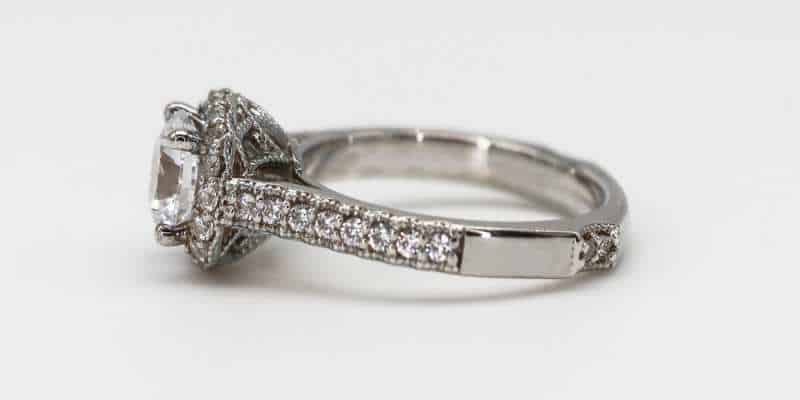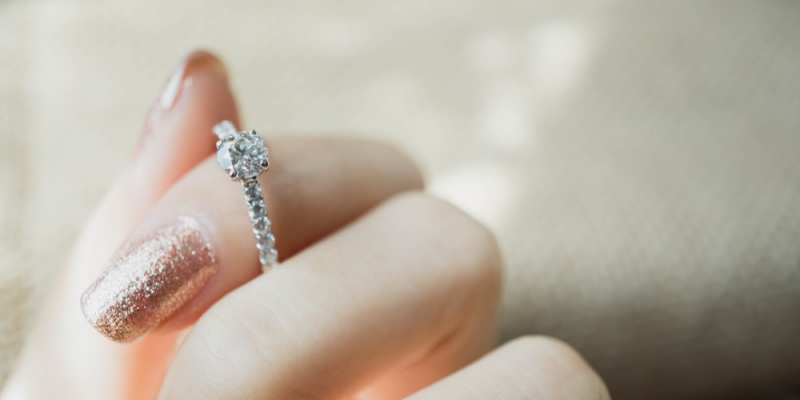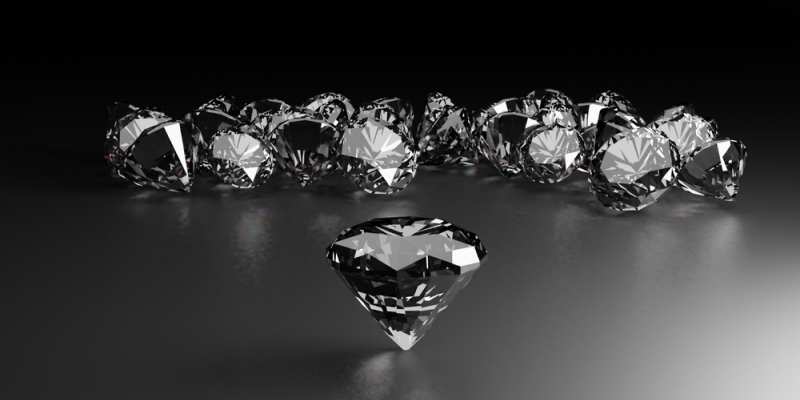One jewelry design concept that has sparked curiosity among consumers is the notion of diamond breathing holes. Speculations and theories have emerged surrounding these holes, but the question remains: are any of them true?
You might find yourself pondering the purpose of these breathing holes in diamonds. The truth is, diamonds do not require breathing holes because diamonds themselves do not “breathe.” The carbon composition of diamonds remains unaffected by external factors such as temperature, pressure, light, or air. These are characteristics that living organisms would be concerned about, but not diamonds.
However, you may wonder why some rings feature breathing holes. Rest assured, we have gathered all the relevant information about diamond breathing holes in this article to provide you with the answers you seek.
DESIGN YOUR OWN ENGAGEMENT RING: START WITH A SETTING OR START WITH A DIAMOND. IT’S REALLY UP TO YOU!

Do Diamonds Need To Breathe?
It may seem like a silly question, but it’s important to clarify that diamonds do not require breathing. Being solid compositions of carbon, diamonds do not expand or contract in response to temperature, air, light, or the presence of liquids.
The idea of diamonds needing to breathe and the association with breathing holes in jewelry is, without a doubt, one of the biggest myths. It’s worth noting that there are certain gemstones, such as pearls, turquoise, opal, coral, and malachite, that do require special care as they are porous or organic.
The presence of holes in diamond rings serves a different purpose. The sharp point at the lower conical part of the diamond, known as the pavilion, features a delicate facet called a culet. During assembly, this culet can come into direct contact with the metal, potentially causing the diamond to break. The holes in the ring prevent this contact and protect the diamond.
Furthermore, these holes facilitate maintenance by providing access to the back of the diamonds. This is particularly useful in settings with multiple smaller stones, where dirt, soap residue, and oils can accumulate. Access to these hard-to-reach areas allows for proper cleaning and maintenance, ensuring the true beauty of your diamond ring.
To clean your diamond ring effectively, you can soak it in a gentle solution, such as water with a small amount of dish soap, for approximately 30 minutes once or twice a week. Afterward, use a soft toothbrush dedicated solely to jewelry cleaning to remove any remaining dirt, focusing on hard-to-reach areas like the back of the diamond. Rinse the ring with water and dry it with a soft, lint-free cloth. Repeat the process if necessary.
Avoid using chlorine bleach, household cleaners, or toothpaste, as these can damage certain metals used in diamond settings and potentially scratch precious metals like gold.
In some cases, an ultrasonic cleaner may be required to remove encrusted dirt. However, exercise caution, as the vibrations from ultrasonic cleaners can dislodge gemstones or chip the girdles of diamonds set closely together. Check the diamond’s grading report to determine if it has undergone any treatments and consult a professional jeweler for advice on cleaning and repairs.
Remember, the brilliance and sparkle of a diamond depend on its facets, which act as tiny mirrors reflecting light. By regularly cleaning the facets, you can ensure your diamond retains its lustrous shine, keeping your ring radiant for special occasions.

Does A Diamond Ring With Breathing Holes Sparkle More?
Another misconception arose from a misinterpretation of the terminology used by diamond suppliers to describe jewelry characteristics. In this case, the term “breathing” is used as a synonym for the diamond’s ability to receive more light.
Certain diamond cuts, like oval or princess cut, may appear more desirable in light settings because they allow the entire shape of the diamond to be showcased. However, this is not the case with a round brilliant diamond cut. The optimal shine of a diamond is primarily achieved by receiving and reflecting light through its upper side.
It’s important to note that a diamond with breathing holes does not receive more light, despite the spread of this myth. The holes are located on the bottom section of the ring and are completely covered when the ring is worn. It wouldn’t make sense for a diamond to shine brighter due to a covered part, would it?
Do Holes in Diamond Rings Increase Comfort?
While diamonds themselves don’t require breathing, our skin does. The presence of holes in certain ring settings allows sweat that accumulates under the ring to evaporate more quickly. This can reduce irritation on sensitive skin and create a slightly more comfortable experience.
Although increased comfort is not the main purpose of these holes, it is a welcomed side effect.
Do All Rings Require Breathing Holes?
Not at all! Usually, rings that require breathing holes are those with low and flat designs that accommodate numerous gemstones. The channel setting and eternity bands are perfect examples of such rings.
Flat bands and low-profile rings have holes beneath each stone to facilitate maintenance and prevent moisture accumulation.
What is a Channel Set Ring?
A channel set ring is a type of ring setting where small diamonds are placed within a specially cut channel, often with a small lip that extends slightly over the edge of the diamonds to keep them secure. Some channel set rings also feature grooves inside the channel to further secure the tiny diamonds or gemstones in place.
A channel setting is similar to a pave setting, but it uses thicker metal to secure gemstones along the band. It offers a snag-free design without prongs and provides a secure way to set tiny diamonds into the band. Channel set rings create a sparkling row with the small diamonds set closely together in the grooves of the channel. These rings can adorn a smaller portion or almost the entire surface of the band.
Why Choose a Channel Set Ring?
A channel set ring adds visible style and sparkle, and its prong-free design ensures security and prevents snagging. The additional small diamonds make channel set rings more eye-catching than solid bands. They are popular for wedding bands and stackable rings that feature tiny gemstones without a central centerpiece.
Channel Set Rings for Every Diamond Shape
The secure support and classic design of channel set rings make them a great option for various diamond shapes. Examples of channel set rings include princess cut, round cut, oval cut, channel set diamond wedding bands, channel set diamond bands, and cushion cut channel set bands. These rings are available in platinum, white gold, yellow gold, and rose gold.
Pros and Cons of Channel Set Rings
As with any ring setting, there are pros and cons to consider when it comes to channel set rings. Let’s take a closer look:
Pros of Channel Setting:
- Securely holds gemstones and protects them from external forces
- Enhances the ring’s sparkle and shine with smaller side gemstones
- Maintains a sharp design without compromising stability
- Less likely to snag on clothes or other materials
Cons of Channel Setting:
- Resizing and repair can be challenging due to numerous channels
- Diamonds may be slightly obscured compared to prong settings
It’s important to determine the ring size of the wearer before purchasing a channel set ring to minimize the need for resizing.
Can You Resize a Channel Set Ring?
Resizing channel set
rings can be challenging because the diamonds are set within the ring itself. Traditional resizing involves cutting the shank and adding or removing metal, which may not be feasible with a setting that contains diamonds.
Resizing is often impossible with channel set rings that have diamonds covering the entire surface. Changing the ring’s circumference could compromise the secure hold of the diamonds. Additionally, the channels can become twisted during the resizing process, affecting the proper setting of the gemstones.
However, resizing is usually possible with channel settings that have diamonds covering only half of the ring. It’s crucial to know the ring size of the wearer due to the limited resizing potential of channel set rings.
Channel Setting vs. Pave Setting
Channel settings are often compared to pave settings due to their similar appearance, and they are sometimes mistaken for one another.
While both settings feature rows of tiny diamonds along the band, there are significant differences to note:
- Diamond Placement: Pave set diamonds are held in place with small beads, allowing them to be set in drilled holes on the band’s surface. Channel-set diamonds, on the other hand, are set within a channel cut into the band, with a small lip at the top securing them.
- Diamond Shape: Pave settings typically use round diamonds to cover as much of the ring’s surface as possible. Channel settings can accommodate various diamond shapes, including round cut, emerald cut, princess cut, and cushion cut.
- Durability: While both settings are generally durable, pave settings may have a higher risk of diamonds falling out if the ring is dropped or comes into contact with a hard surface. Channel settings offer extra protection since all the diamonds are secured within the channel.
Understanding these differences can help you choose the right setting for your preferences and needs.

Bottom Line
If you’ve come across the myth about diamonds needing breathing holes and find yourself wondering why this is the case, let’s clarify it once again.
The truth is, diamonds do not require breathing holes because they don’t need to “breathe.” Diamonds are composed of carbon, a substance that does not expand or contract in response to external environmental changes.
The presence of holes on certain types of rings serves two primary purposes: ease of handling and improved maintenance.
During the assembly of the ring, if the diamond tip comes into contact with the metal, it could potentially break. In such cases, these holes prove useful by preventing such contact.
Additionally, the holes facilitate the cleaning of the diamond ring, as they allow for easier access to all parts of the diamonds.
Moreover, these holes can be beneficial for your skin. They enable faster evaporation of sweat, reducing the likelihood of irritation on sensitive skin.
However, it’s important to reiterate that these holes do not assist diamonds in “breathing.”


